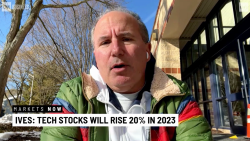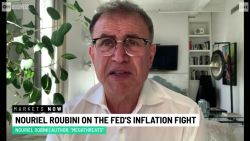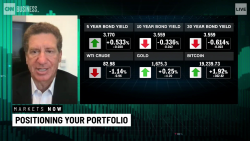Within the often head-scratching world of cryptocurrencies, there’s a small but growing sub-species known as “algorithmic stablecoins” that have some investors and regulators ringing alarm bells.
This week, one popular so-called algo coin cratered, wiping out billions of dollars’ worth of value in just a few days.
The coin, called TerraUSD, is designed to maintain its value at $1, forever and ever, amen. Instead, it fell as low as 23 cents Wednesday before recovering some ground. It was hovering around 60 cents early Thursday.
To critics of the controversial crypto product, it’s an “emperor has no clothes” moment. Or, more pessimistically, a Lehman Brothers moment.
To understand what’s going on in this corner of the crypto market, it’s important to understand what these newfangled investing products are and how they work.
What’s a stablecoin?
Cryptocurrencies like bitcoin and ether are known for wild swings in value that make investors nervous. Stablecoins, as their name implies, are designed to hold steady.
Most stablecoins are tightly pegged to a traditional fiat currency, such as the US dollar, or to a commodity like gold. Investors buy them to store money and facilitate deals within the cryptocurrency infrastructure. They also are used for other types of financial exchanges, such as lending, borrowing or sending payments overseas with less friction than going through a traditional bank.
Their purported stability has turned these once obscure tokens into the bedrock of the crypto ecosystem. The collective market value of all stablecoins has grown to $180 billion as of March this year, according to the Federal Reserve.
But don’t let the name fool you: Not all stablecoins are stable, per se.
Some stablecoins have a 1-to-1 connection to real assets, like US Treasury bills. Some are linked to bonds, which can fluctuate in value.
But it’s stablecoin’s wayward cousin, the “algorithmic stablecoin” that triggered a panic among investors this week. And while they sound similar, the algorithmic variety are, functionally, another beast entirely.
The unstable coin?
Most stablecoins are backed by real-world collateral such as dollars or cash equivalents. But algorthmic stablecoins aren’t necessarily backed by any real external asset, relying on complex financial engineering to hold their value steady. And when they fall, they tend to fall hard — industry watchers call this a “death spiral.”
Algorithmic coins are “just a fancy way of saying, ‘We are going to say that this is worth a dollar because it’s backed by another asset that we also create out of thin air,’” says Charles Cascarilla, the chief executive and co-founder of Paxos, a blockchain infrastructure firm.
In the case of TerraUSD, that other “out of thin air” asset is the cryptocurrency Luna.
Here’s how it works:
- An investor can, in theory, exchange one Terra for for a dollar’s worth of Luna, its sister token whose price isn’t fixed.
- Traders who engage in a process called arbitrage are able to make a quick profit by exploiting fluctuations in either asset — creating an incentive to hold Terra’s value steady at $1. For example, if Terra drops below a dollar, arbitrage traders swoop in to buy Terra on the cheap and exchange it for $1 worth of Luna.
- This eventually creates an ecosystem in which traders exchange Lunas and Terras to keep the value of Terra at $1.
The problem is that the entire ecosystem relies on traders believing Luna has value. Once investors lose faith in the system, all bets are off.
“Any morning, people could wake up and say ‘“‘wait a minute, you just made up this all up, it’s worthless,’ and decide to dump their Lunas and Terras,” wrote Bloomberg columnist Matt Levine.
That appears to be what happened this week. The wheels started to come off over the weekend, when investors began to pull out of both Terra and Luna.
“This is exactly the ‘death spiral’ a lot of people predicted,” said Henry Elder, head of decentralized assets at Wave Financial, a digital asset manager.
What happens next?
Stablecoin advocates warn this is no time to throw the baby out with the bathwater, noting that currency-backed stablecoins like Tether and USDCoin held steady during Terra’s meltdown this week.
But on Thursday, mounting pressure shook Tether, the world’s largest stablecoin with an $80 billion market cap. Tether fell as low as 96 cents early Thursday, according to CoinMarketCap. The second-largest stablecoin, USDCoin, meanwhile, held steady at $1.
Tether’s chief technology officer sought to reassure investors on Thursday, tweeting that the coin’s parent company is still honoring redemptions at the $1 level “without a sweat drop.”
Do Kwon, the CEO of Terraform Labs, tweeted Wednesday that recovery efforts were under way, encouraging investors to “stay strong.” By Thursday, backers appeared to be struggling to win investor support for the recovery plan, Bloomberg reported, citing people familiar the matter.
Investors and regulators on edge
Bitcoin, the world’s largest cryptocurrency, has also suffered from the souring mood in crypto.
Early Thursday, the crypto was trading at around $28,000, down more than 12% over 24 hours. (Bitcoin, like other cryptocurrencies, trade 24 hours a day, seven days a week.)
Crypto assets still make up a small part of the broader financial system. But powerful people like Treasury Secretary Janet Yellen are paying attention, fearful that the situation could create nasty and unpredictable aftershocks for investors of all stripes.
Testifying before the Senate earlier this week, Yellen commented on Terra’s decline, saying it “simply illustrates that this is a rapidly growing product and that there are risks to financial stability.”
Also this week, Yellen warned that stablecoins remain “vulnerable to runs” because some are backed by assets that may lose value or become illiquid in times of stress.
Crypto evangelists tend to see meltdowns like Terra’s as an unfortunate loss, but one that ultimately helps reinforce the credibility of the underlying blockchain technology.
“I do think that the winnowing process of good ideas and questionable ideas ultimately makes the ecosystem stronger,” Paxos’ Cascarilla says. “The economy is totally shifting to the speed of the internet, but the financial system is still working at the speed of the, of the post office… Unfortunately, there are these moments of creative destruction that actually end up being some of the best ways of kind of narrowing things down to what people can really get behind.”
—CNN Business’ Julia Horowitz contributed reporting.






















